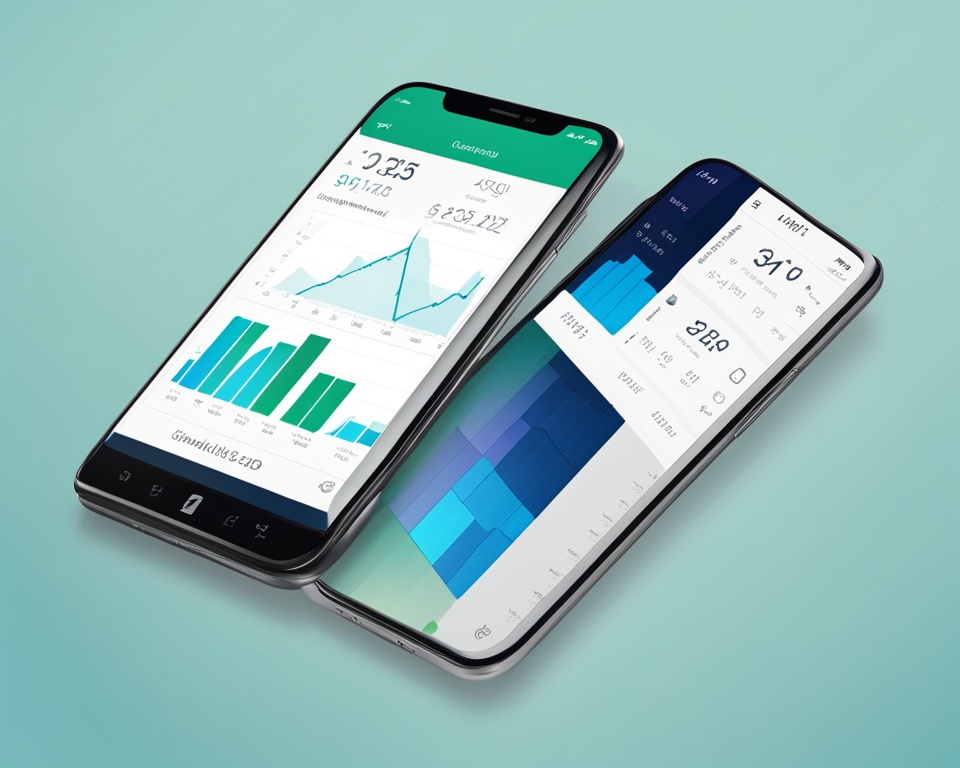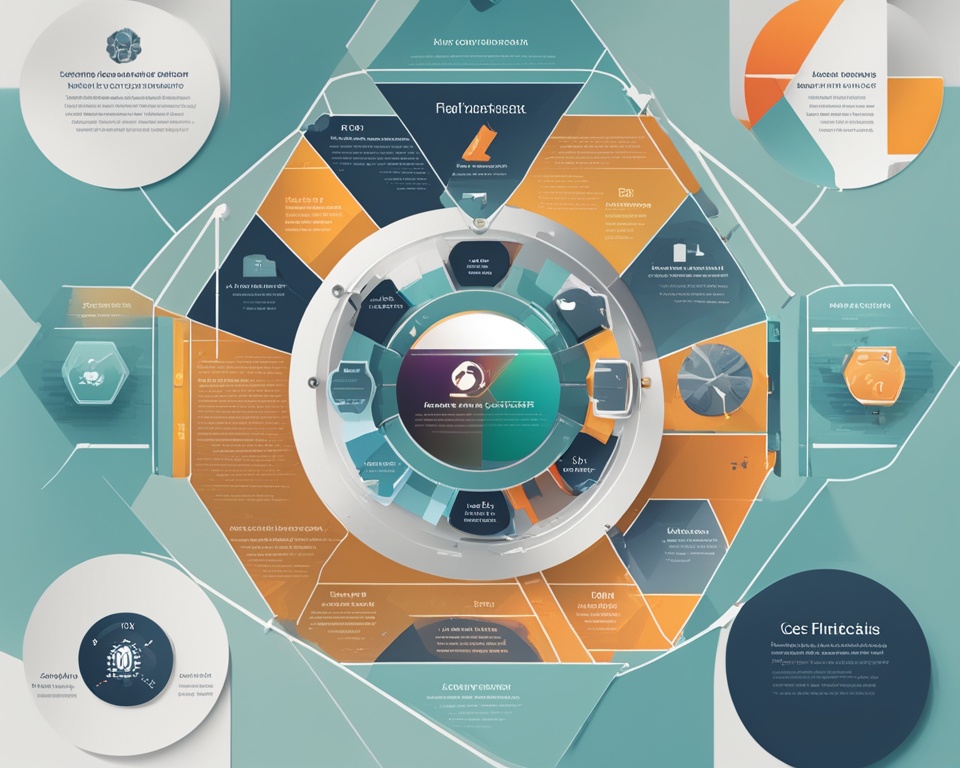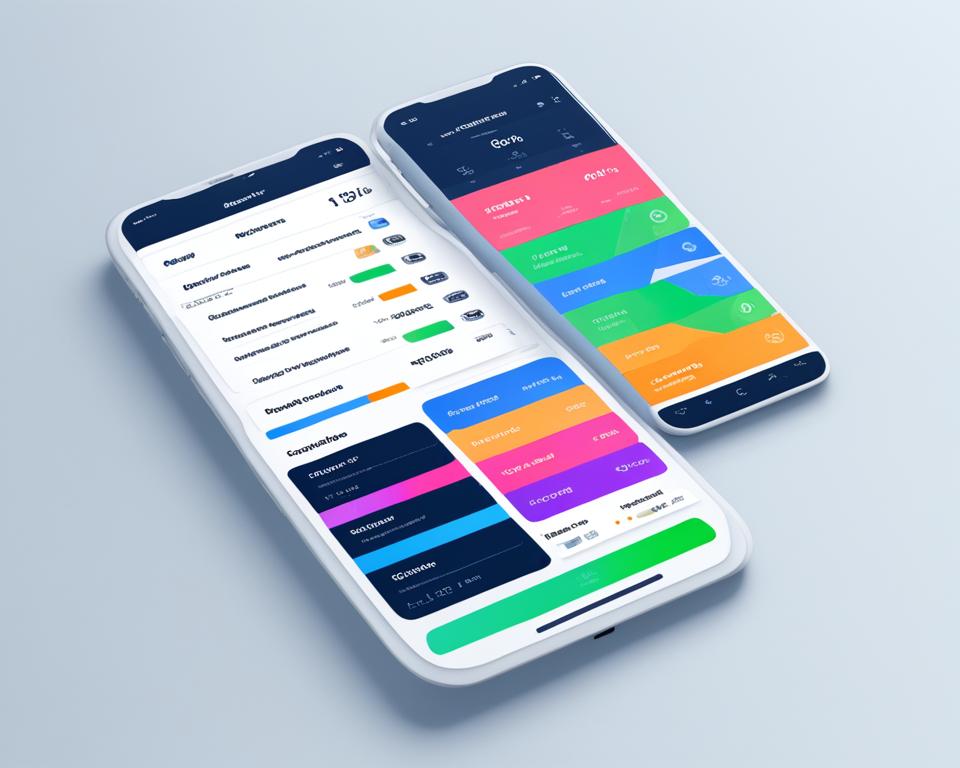The world of financial technology (fintech) is changing fast. More people want apps that are easy to use and innovative. If you’re starting a new company or already have one in finance, knowing how much it costs to make a fintech app is key. This guide will help you understand what affects the cost. It will give you the info you need to make smart choices and feel confident about your project.
Table of Contents
Key Takeaways
- The cost to make a fintech app changes a lot because of things like how complex it is, what features it has, and who makes it.
- Knowing the costs for different fintech apps, like banking or personal finance, helps you budget better.
- Things like who makes the app (in-house or outsourced), the tech used, and design choices affect the cost a lot.
- Following rules and keeping the app safe are key parts of the cost.
- Starting with a basic version and working with the right partner can help keep costs down and make sure your app does well.
This guide covers important points to help you understand the cost of fintech app development. It aims to give you the knowledge you need to make choices that fit your business goals and budget.
Introduction to Fintech App Development
In today’s fast-changing digital world, fintech apps are changing how we handle money. They use the latest tech to make managing money easier. These apps offer services like mobile banking, digital wallets, investment advice, and lending between people.
What is a Fintech App?
A fintech app is a digital tool that uses tech like AI, blockchain, and machine learning for better financial services. It’s made to meet the needs of today’s consumers. It gives a more personal, easy, and user-friendly way to manage money compared to old banking methods.
The Growing Importance of Fintech Apps
The fintech industry is booming, thanks to a growing need for easy, safe, and open financial services. Young, tech-savvy people love fintech apps for their quick, secure, and detailed financial management. This change in what people want, along with tech progress, makes fintech apps key for managing money at home and for business.
“Fintech apps have the potential to revolutionize the way we think about and interact with financial services. By leveraging technology, these innovative solutions are making financial management more accessible, efficient, and personalized than ever before.”
Factors Influencing the Cost of Fintech App Development
Creating a strong fintech app needs looking at many factors that change the cost. These factors affecting fintech app development cost include the app’s complexity, the features needed, the team’s setup, the tech used, design, user experience, rules to follow, and updates needed.
The app’s complexity is a big factor in cost. A complex app costs more to make. This complexity comes from things like many integrations, complex data handling, and strong security.
What the app does is also key in pricing. Fintech apps can be simple money managers or complex trading platforms. Each type needs different features, which affects the cost.
The team’s setup, whether in-house or outsourced, changes the cost too. Team size, skill, and where they are can all play a part in the final cost.
The tech stack, like programming languages and frameworks, also matters. Some tech needs more special skills, making it pricier.
Design and user experience are big factors in cost too. A great design makes users happy, but it might need a skilled team and more work.
Following rules and keeping the app secure is crucial for fintech apps. Meeting standards like PCI DSS can increase costs. Testing and quality checks are also key to make sure the app works well.
Knowing these variables that impact fintech app pricing helps fintech companies plan their budgets. This way, they can make smart choices during development.
App Complexity and Features
When making a fintech app, the app’s complexity and its features are key to the cost. Knowing the difference between basic and advanced features is crucial for a successful project.
Basic Features and Functionality
Basic features like user login, handling transactions, managing accounts, and reporting are the core of a fintech app. These basics make the app secure and easy to use for customers. They don’t take as much work to build as the advanced features do.
Advanced Features and Integrations
As fintech apps grow, they add complex features for a better user experience and more financial services. These can include AI advice, biometric security, linking with other services, and managing many accounts. These advanced features make the app harder and more expensive to build.
The complexity of an app affects how much time, resources, and expertise it needs. Planning well and knowing what features you want is key to guessing the costs right and making the app successful.
| Feature | Complexity Level | Estimated Development Cost |
|---|---|---|
| User Authentication | Basic | $5,000 – $10,000 |
| Transaction Processing | Basic | $10,000 – $20,000 |
| Account Management | Basic | $8,000 – $15,000 |
| AI-powered Financial Advice | Advanced | $25,000 – $50,000 |
| Biometric Security | Advanced | $15,000 – $30,000 |
| Third-party Integrations | Advanced | $20,000 – $40,000 |
This table shows the complexity and cost of different fintech app features. Costs can change based on the specific needs, tech used, and the team’s skills.
“Investing in a well-designed fintech app with the right balance of basic and advanced features can pay dividends in the long run, ensuring a seamless user experience and driving customer loyalty.”
Development Team and Resources
The team you choose for fintech app development greatly affects the cost. You can go for an in-house team or outsource the work. The team’s expertise, size, and location can change your budget.
In-House vs. Outsourced Development
Choosing between an in-house team or outsourcing is a big decision. It affects your budget. Here are some things to think about:
- Expertise and Specialization: Outsourced teams know a lot about fintech app development. They have skills and experience you might not find in-house.
- Cost Savings: Outsourcing can save money. It’s cheaper for labor and overhead. Plus, you can find talent from all over the world.
- Scalability: Outsourced teams can grow or shrink as needed. This gives you more flexibility.
- Communication and Collaboration: In-house teams usually communicate better. But, outsourced teams can work well with good management.
Decide between an in-house team or outsourcing based on your needs, budget, and local talent.
| Factor | In-House Development | Outsourced Development |
|---|---|---|
| Expertise and Specialization | May need more time to build specialized skills | Get access to experts in fintech app development |
| Cost | Higher costs for overhead and labor | Potential savings, especially on labor and infrastructure |
| Scalability | Scaling up or down can be hard | Scaling is easier as needed |
| Communication and Collaboration | Strong in-person communication | Needs good project management |
Choose between an in-house team or outsourcing based on your needs, budget, and local talent.
Tech Stack and Third-Party Integrations
Building a strong fintech app needs a well-chosen tech stack and smooth third-party service integration. The tech stack, including programming languages, frameworks, and databases, affects the app’s development cost. Also, the cost of adding important third-party tools like payment gateways, credit scoring APIs, and data analytics platforms must be considered.
For the fintech app tech stack, some top choices are:
- Programming languages: JavaScript, Python, Java, Kotlin
- Frameworks: React, Angular, Vue.js, Django, Spring Boot
- Databases: MongoDB, PostgreSQL, MySQL, Amazon DynamoDB
Adding third-party integrations for fintech apps is key, as they bring in vital features that improve user experience and meet rules. Common integrations include:
- Payment gateways: Stripe, Braintree, PayPal, Adyen
- Credit scoring APIs: Experian, Equifax, TransUnion
- Data analytics tools: Google Analytics, Mixpanel, Amplitude
- Identity verification services: Jumio, Onfido, Persona
The cost of fintech app tech stack and integrations changes a lot based on your project’s complexity and needed services. It’s important to weigh the costs against the benefits to keep your fintech app development budget-friendly yet effective.
“The right tech stack and third-party integrations can make or break your fintech app. Spend time and resources to find the best balance between cost, functionality, and scalability.”
Design and User Experience
In fintech app development, design and user experience are key to success. A well-designed app attracts and keeps users in a tough market. The cost depends on the app’s complexity and customization needed.
Importance of User-Centric Design
Fintech apps must focus on what users need and like for a smooth experience. This means doing lots of research, making prototypes, and testing them. It makes the app easy to use and builds trust with users, helping the app do well.
The cost of making a fintech app user-friendly includes:
- User research and personas
- Wireframing and prototyping
- Visual design and branding
- Usability testing and feedback integration
- Responsive design for mobile and desktop platforms
Putting money into a well-designed fintech app means more users, more conversions, and better performance. It’s key to making the app a hit.
“Excellent user experience is not just a luxury, but a necessity in the highly competitive fintech market. Crafting a seamless and intuitive interface can be the difference between a successful app and one that fails to gain traction.”
| Feature | Impact on User Experience | Estimated Cost |
|---|---|---|
| Personalized Dashboard | Allows users to customize and access key financial information quickly | $10,000 – $25,000 |
| Intelligent Recommendations | Provides tailored suggestions based on user’s financial goals and behavior | $15,000 – $35,000 |
| Omnichannel Integration | Ensures a consistent and seamless experience across multiple devices and platforms | $20,000 – $50,000 |
The cost of designing a fintech app and making it user-friendly is big part of the budget. By focusing on the user, fintech companies can make apps that meet user needs and stand out.
Cost to Develop a Fintech App
The cost to make a fintech app varies widely. It depends on how complex the app is, what features it has, and how it’s made. Knowing the cost for different types of apps helps you plan your budget.
Average Cost Ranges
A basic banking app might cost around $50,000 to make. But a complex wealth management app could be over $1 million. The final cost depends on things like the tech used, the team working on it, and how unique it needs to be.
Cost Breakdown by App Type
When looking at the costs for fintech apps, consider these main factors:
- Complexity of features and functionalities
- Integration with third-party services and APIs
- User interface and user experience (UI/UX) design
- Back-end development and infrastructure
- Security and compliance requirements
- Quality assurance and testing
- Ongoing maintenance and updates
Knowing these costs helps you plan and budget for your fintech app. This way, you can make sure your project does well and lasts a long time.
“Investing in the right fintech app development strategy can be a game-changer, unlocking new revenue streams and enhancing customer satisfaction.”
Regulatory Compliance and Security
In the fast-paced world of fintech, apps face strict rules. They must follow standards like PCI DSS (Payment Card Industry Data Security Standard) and protect data well. This is key for fintech app compliance. These rules can make the development cost go up because they need careful planning and doing.
PCI DSS and Data Protection
Fintech apps that deal with financial transactions must follow PCI DSS. This is a set of security standards to protect cardholder data. Following PCI DSS can be hard and take a lot of resources, which might make the cost of fintech app compliance go up. Also, fintech apps need to focus on data security for fintech apps by using strong encryption, access controls, and data backup plans to keep customer info safe.
- Following PCI DSS standards
- Using strong data encryption and access controls
- Having data backup and disaster recovery plans
Getting through the regulatory rules and keeping fintech app compliance is key for fintech startups and big players. By focusing on security and following the rules from the beginning, fintech app makers can lower risks, protect their customers, and gain trust in the industry.
“Security and compliance should be the foundation of any fintech app, not an afterthought.”
Testing and Quality Assurance
Testing and quality assurance are key for fintech app success. They make sure the app works well, is safe, and performs as expected. This is crucial in the financial sector, which is strict and sensitive.
The cost of testing and quality assurance depends on the app’s complexity, the testing methods used, and automation levels. These factors affect the price.
Comprehensive Testing Approaches
Fintech app testing includes various strategies:
- Functional testing to check if the app works as it should
- Security testing to see how well the app protects against cyber threats
- Performance testing to see how the app handles different loads
- Usability testing to make the app easy to use
- Integration testing to check how the app works with other systems
The cost of testing can change a lot. It depends on the app’s complexity, the tools and environments used, and automation levels. More thorough and automated testing can cost more upfront but can save money later by making the app more reliable.
Quality Assurance Best Practices
Good quality assurance for fintech apps means following best practices like:
- Creating detailed test plans and test cases for all important app features
- Using continuous integration and continuous deployment (CI/CD) to make testing and deployment smoother
- Choosing special fintech app testing tools and frameworks to improve testing efficiency and accuracy
- Working with experienced quality assurance experts who know the fintech field well
- Doing regular security audits and penetration testing to find and fix vulnerabilities
By following these best practices, fintech app developers can make sure their apps meet the high standards needed in finance. This helps their apps succeed and gain user trust over time.
| Testing Approach | Objective | Estimated Cost Range |
|---|---|---|
| Functional Testing | Validate app features and functionality | $5,000 – $20,000 |
| Security Testing | Assess app’s resistance to cyber threats | $10,000 – $50,000 |
| Performance Testing | Evaluate app’s scalability and responsiveness | $8,000 – $30,000 |
| Usability Testing | Optimize user experience and interface | $3,000 – $15,000 |
| Integration Testing | Ensure seamless third-party integrations | $7,000 – $25,000 |
Testing and quality assurance for fintech apps can be costly. But it’s crucial for the app’s long-term success and reliability. By focusing on thorough testing and quality assurance, you can reduce risks, build user trust, and help your fintech app grow in the digital finance world.
Post-Launch Maintenance and Updates
Keeping a fintech app running smoothly is an ongoing task. It’s not just about the launch day. As users change, rules shift, and tech gets better, fintech apps need regular updates and security checks. These updates keep the app competitive and useful. It’s important to think about the costs for these updates when planning your app’s budget.
The cost to keep a fintech app running can change based on how complex it is, how often it needs updates, and the support needed. Usually, updates cost about 15% to 20% of what it took to build the app in the first place. This covers fixing bugs, security updates, and small feature changes.
Big updates, like adding new features or moving to a new platform, can cost more. These updates need a lot of work and might need extra help, like design or testing. This can make the upkeep costs go up.
For a fintech app to do well over time, planning for maintenance and updates is key. Setting aside part of the budget for ongoing support and improvements helps. This way, fintech companies can keep their apps modern, safe, and in line with what users want.
“Keeping a fintech app up-to-date and relevant is a never-ending task, but it’s a critical investment to maintain a competitive edge and ensure long-term customer satisfaction.”
Ongoing Maintenance and Updates
- Regular bug fixes and security patches
- Minor feature improvements and updates
- Compliance with changing industry regulations
- Integration of new technologies and platforms
- Optimization for emerging devices and operating systems
Budgeting for Post-Launch Support
- Allocate 15-20% of the initial development cost for annual maintenance and updates
- Factor in additional resources for major feature enhancements or platform migrations
- Ensure the development team has the expertise and capacity to handle ongoing support and updates
- Build in flexibility to adapt to evolving user needs and market demands
Planning ahead for the costs of fintech app maintenance and updates helps fintech companies keep their apps strong in the digital finance world.
Monetization Strategies for Fintech Apps
Fintech apps help people manage money, make payments, and access financial services. As fintech grows, app makers and entrepreneurs look for ways to make money. They often use subscription and transaction fees.
Subscription Models
Subscription-based fintech apps give users extra features for a regular fee. This way, apps can make steady money and keep customers happy. Examples include apps for managing money, investing, and digital banking.
Transaction Fees
Another way fintech apps make money is through transaction fees. They take a small cut from each transaction, like payments or investments. This works well for apps that handle lots of money, like mobile wallets or sending money abroad.
Choosing how to make money is tough for fintech app developers. They must think about who will use the app, what it does, and the market. Picking between subscription or transaction fees affects the app’s cost, price, and future success.
| Monetization Strategy | Key Characteristics | Potential Benefits | Potential Drawbacks |
|---|---|---|---|
| Subscription Models |
|
|
|
| Transaction Fees |
|
|
|
Understanding the good and bad of different ways to make money from fintech apps helps developers make smart choices. This way, they can create apps that make money and last a long time.
Choosing the Right Development Partner
Finding the right partner for your fintech app is key to its success. Look for a partner with deep industry knowledge, strong tech skills, a solid fintech app portfolio, and services that match your project needs and budget.
Evaluating Expertise and Portfolio
When picking a fintech app development partner, check their expertise and portfolio well. Make sure they have a history in fintech, know the latest trends, and understand the rules.
- Review their fintech app projects, focusing on their complexity, features, and success.
- Check the skills and experience of the team, ensuring they know about mobile apps, payment processing, data security, and following the rules.
- Ask about their method for evaluating fintech app development expertise and how they make sure their solutions are top-notch and can grow.
By carefully evaluating how to choose a fintech app development company, you can pick a partner that will give you a secure, rich-featured, and easy-to-use fintech app that fits your business needs.
| Evaluation Criteria | Importance |
|---|---|
| Industry Expertise | High |
| Technical Capabilities | High |
| Fintech App Portfolio | High |
| Alignment with Project Requirements | High |
| Regulatory Compliance | High |
“Choosing the right fintech app development partner can make all the difference in the success of your project.”
Tips for Cost Optimization
Minimum Viable Product (MVP) Approach
To cut down the cost of making your fintech app, think about using a Minimum Viable Product (MVP) approach. This method means building the basic features first. Then, you can test the market, get feedback, and add more features later. Starting with an MVP helps you check if your app idea works, saves money, and makes sure you’re building what your users want.
Using the MVP approach can greatly reduce the cost of making fintech apps. You don’t have to start with all the features at once. Instead, focus on the key ones that solve your users’ main problems. This way, you can see how the market reacts, learn from it, and decide what to add next. This leads to a more efficient way of developing your app.
Making a fintech app can be both complex and expensive. But, with the MVP approach, you can manage your budget better and make sure your app connects with your audience. By starting small and improving based on what users say, you can create a successful fintech app. This way, you reduce financial risks and get a good return on your investment.














